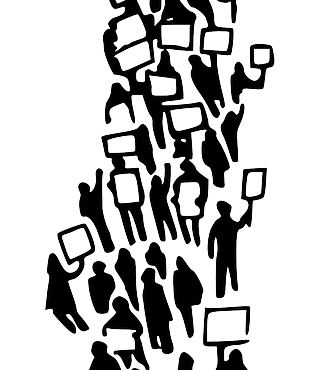
By Amber McGee, Staff Writer
With several polarizing issues making headlines today, there seem to be protests everywhere. The right to free speech is something so central to what it means to be an American that, often, groups seeking to exercise it do not fully understand that there are limitations on where, when, and how they may exercise this right.
The language of the First Amendment simply states: “Congress shall make no law respecting an establishment of religion, or prohibiting the free exercise thereof; or abridging the freedom of speech, or of the press; or the right of the people peaceably to assemble, and to petition the Government for a redress of grievances.”[1] But what is considered “peaceful assembly”? And in what types of situations can law enforcement step in to ensure that protestors are obeying the law? A new kind of protest has arisen with the use of social media and the world wide web in general. Individuals, organizations, and corporations have been vocal via the internet in support or in protest of many issues lately — without fear of recourse or fear of crossing any lines.
Large corporations have taken stances on issues lately, including Netflix CEO Reed Hastings. Hastings posted on Facebook that the recent actions President Donald Trump has taken “are so un-American it pains us all.”[2] Others who have spoken out via social media include the chief executive of Airbnb, Lyft, a co-founder of Google, Mark Zuckerberg, and many others.[3]
Due to the use of social media, protests are easier to organize and can reach hundreds of thousands of people with the click of a mouse.[4] And with the click of a mouse, hundreds of thousands of people can express their support or disdain for a cause or way of thinking.[5] International mass mobilization is the result of the rise in social media users and the newfound comfort in voicing one’s opinion online.[6] There are good and bad aspects of this ease to assemble. The volume of people you can reach is great for educating and spreading information.[7] With such a large volume of people, however, comes a variety of views and disparate ideas about what protesters are actually looking to accomplish, and how they are going about doing so.[8]
Protest organizers and law enforcement have their work cut out for them. With the new challenges they face, and the magnitude of issues currently dividing the Unites States, law enforcement and organizers must be vigilant to make sure that this right so fundamental to Americans is not distorted. Those who are voicing their concerns so rapidly and easily should be sure to educate themselves on issues by seeking out the truth.
Law enforcement, whether they personally agree or disagree with the content of the protests they patrol, must make sure that participants obey the law and that safety for both participants and non-participants is upheld. Examples of common questions protestors have about their rights are currently outlined by the ACLU on its webpage.[9] The ACLU’s website explains that expressions of free speech are lawful in public forums regardless of its content.[10] Protestors may get into trouble if they wish to protest on private property, however, if they do not have consent from the property owner.[11] Further, counter protestors have rights, too.[12] The police are allowed to separate protestors with disparate views, but if they are peaceful, they should be allowed to remain in the general vicinity.[13]
One major protested issue, the pipeline construction at Standing Rock, has brought concerns to those in the surrounding areas as tensions rise once again over the matter.[14] During the end of President Barack Obama’s administration, levels of discomfort and concern rose as protesters and law enforcement were criticized for the effects they had on residents in the surrounding areas.[15] During this time, over 100 protesters were arrested for charges such as engaging in a riot and conspiracy to endanger by fire and explosion.[16] Videos of violence both on the part of the police and of protestors flooded social media sites. Scenes of police dogs, riot gear, and smoke tugged at the hearts and minds of viewers everywhere and perhaps influenced the Obama administration to make a decision on the issue.[17] That decision was not to allow the construction of the Dakota Access Pipeline to continue through Native American burial grounds.[18]
Clearly, acts of violence are not excused under the First Amendment. The line that differentiates a protest from a riot, however, is sometimes blurred and is often hard for law enforcement and protestors to draw. Soon, laws regarding this line may need to be looked at and readjusted to fit changes in protest dynamics.
Sources
[1] USCS Const. Amend. 1
[2] Silicon Valley’s Ambivalence Toward Trump Turns to Anger, New York Times, (January 29, 2017).
[3] Id.
[4] Ajay Seebaluck, How Social Media Affects the Dynamics of Protests, (December 2014).
[5] Id.
[6] Id.
[7] Id.
[8] Id.
[9] https://www.aclu.org/know-your-rights/what-do-if-your-rights-are-violated-demonstration-or-protest?redirect=know-your-rights/demonstrations-and-protests
[10] Id.
[11] Id.
[12] Id.
[13] Id.
[14] Tension Between Police and Standing Rock Protestors Reaches Boiling Point, New York Times, (December 28, 2016).
[15] Id.
[16] Id.
[17] Jack Healy, Neighbors Say North Dakota Pipeline Protests Disrupt Lives and Livelihoods, New York Times, (September 13, 2016).
[18] Facing Standing Rock Campaign, Obama Administration Blocks Dakota Pipeline Path, New York Times, (December 4, 2016).